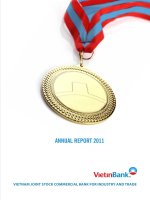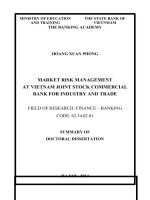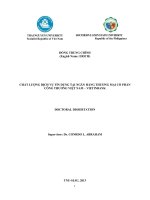credit services quality of vietnam joint stock commercial bank for industry and trade - vietinbank
Bạn đang xem bản rút gọn của tài liệu. Xem và tải ngay bản đầy đủ của tài liệu tại đây (1.87 MB, 111 trang )
Dong Trung Chinh Er
ich
i
Thai Nguyen University
Southern Luzon State University
DEED OF DECLARATION
I, Chinh DONG TRUNG, hereby submit my thesis for oral examination, entitled
“Credit services quality of Vietnam Joint stock commercial bank for industry and
trade - VietinBank”, truthfully declare that the said paper is a product of my original
research investigation. The data presented in the paper have clear origin.
PhD candidate
Chinh DONG TRUNG - ERICH
Dong Trung Chinh Er
ich
ii
Thai Nguyen University
Southern Luzon State University
ACKNOWLEDGMENT
This research was a process of learning that asked for the involvement of
individuals, companies and institutions. During my research period, I received
unconditional co-operation from many individuals/organizations, and their support
was a key factor in successfully completing the thesis. I greatly appreciate the
contribution of everyone involved and I apologize to those I do not mention by name.
First of all, I am especially grateful to my supervisors, Profssor, DR. Conrdo L.
Abraham, who provided me with valuable guidance and comments throughout the
research period. I also thank my supervisor for giving me the opportunity to work in
the area of my interest. I would also like to thank the members of the reading for
reading the manuscript and for providing me with constructive comments.
I would also like to thank: Professor, Dr. Do Anh Tai, Dr. Pham Hong Manh has
dedicated help me during this research, read the manuscript and provided me with
constructive comments.
I extend especial thanks to the board of Rectors of Hanoi University of Industry
for permiting me to follow the doctoral course and creat favorable conditions for me
to accomplish this dotor course. I would also like to express my gratitude to Thai
Nguyen University, Southern Luzon State University and their professors for
organization, support and help during the dotoral course.
The Manager and Staff of accounting companies as customer VietinBank my
interview, the patience and their cooperation in answering these questions and other
data are given;
I wish to express my sincere thanks to my families and friends, who were
dedicated to helping me to complete this study, and all those who have contributed to
make this study a success.
Hanoi, 9
th
Augus 2013
Dong Trung Chinh – Erich
Dong Trung Chinh Er
ich
iii
Thai Nguyen University
Southern Luzon State University
TABLE OF CONTENTS
Content Page
DEED OF DECLARATION : i
ACKNOWLEDGMENT ii
TABLE OF CONTENTS iii
LIST OF TABLES v
LIST OF FIGURES vi
LIST OF CHARTS vii
Rating Sheet ix
PUBLICATIONS RELATED TO THE THESIS x
CHAPTER I: INTRODUCTION 1
1.1. Background of the Study 1
1.2. Statement of the Purpose 3
1.3. Significance of the Study 4
1.4. Scope and Limitations 5
1.5. The structure of the thesis 6
Chapter 2: REVIEW OF RELATED LITERATUES AND STUDIES 7
2.1. Review of related literature and studies 7
2 2. Conceptual Framework 16
2.3. Hypothesis 26
2.4. Definition of Terms and Variable 28
CHAPTER 3: METHODOLOGY 29
3.1. Research Design 29
3.2. Research Locals 30
3.3. Samples and Sampling Techniques Used 31
3.4. The analytical tools and data processing (Instrumentation) 33
3.5. Procedure 33
3.6. Statistical analysis of the data
CHAPTER 4: RESULTS AND DISCUSSION 36
4.1. Research Results 36
4.2. Discussion research 52
CHAPTER 5: SUMMARY, CONCLUSIONS AND RECOMMENDATIONS 66
Dong Trung Chinh Er
ich
iv
Thai Nguyen University
Southern Luzon State University
5.1. Summary 66
5.2. Conclusion 68
5.3. Recommendatio 69
BIBLIOGRAPHY 74
APPENDICES 1 80
APPENDICES 2 85
APPENDICES 3 92
APPENDICES 4 97
CURRICULUM VITAE 104 104
Dong Trung Chinh Er
ich
v
Thai Nguyen University
Southern Luzon State University
LIST OF TABLES
Content Page
Table 3.1: Distribution of the sample in the study area 30
Table 4.1: Business objects to the transaction at VietinBank 39
Table 4.2: Table of Customer interest rate 41
Table 4.3: Status of the duly repaid for the credit loans 42
Table 4.4: The ease of approaching business credit in bank loans VietinBank 43
Table 4.5: The difficulty of accessing credit business loans at banks VietinBank
43
Table 4.6: Reliability Analysis – Scale: “Tangible” 44
Table 4.7: Reliability analysis – Scale: “Reliability” 44
Table 4.8: Reliability analysis – Scale: “Responsiveness” 45
Table 4.9: Reliability analysis – Scale: “Empathy” 45
Table 4.10: Reliability analysis – Scale: “Assurance” 46
Table 4.11: Reliability analysis - Scale: “Profile” 46
Table 4.12: Reliability analysis – Scale: “Satisfaction” 47
Table 4.13: Factor Analysis (EFA) 47
Table 4.14: “Results extracted factor "satisfaction" 48
Table 4.15: Correlations Analysis 49
Table 4.16: Results regression analysis 50
Table 4.17: Results summary components factor analysis after discovery 53
Table 4:18: Statistical average component "Tangible" 56
Table 4:19: Statistical average composition "Credibility" 57
Table 4:20: Statistical average composition "Empathy" 58
Table 4:21: Statistical average composition "Response" 58
Table 4:22: Statistical average component "Assurance” 59
Table 4.23: Statistics of the average "profile" 60
Table 4.24: Nonparametric Correlations 61
Table 4.25: Results of ANOVA analysis between qualities of service by gender 63
Table 4:26: Anova analysis results between qualities of service by gender 63
Table 4:27: Anova analysis results between quality of service and level of 64
Table 4:28: Anova analysis results between service quality by types of enterprise
65
Dong Trung Chinh Er
ich
vi
Thai Nguyen University
Southern Luzon State University
LIST OF FIGURES
Content Page
Figure 2.1: Model of customer satisfaction Teboul 17
Figure 2.2: Model technical and functional quality model 18
Figure 2.3: Model quality service 'based distance (GAP model) 19
Figure 2.4: model of causal relationships between perceived qualities with 21
Figure 2.5: Model of cause and effect between the perceived qualities of 22
Figure 2.6: Model customer satisfaction index of the United States 23
Figure 2.7: The research model with hypotheses based on five dimensions by
Parasuraman et al (1988)
27
Figure 3.1: The process of conducting research 30
Dong Trung Chinh Er
ich
vii
Thai Nguyen University
Southern Luzon State University
LIST OF GRAPH
Content Page
Graph 4.1: Gender of clients in the study sample 36
Graph 4.2: Age group of Customer in transactions in VietinBank 37
Graph 4.3: The level of education of the Customer transaction VietinBank
38
Graph 4.4: The position of the Customer in the transaction of business with
38
Graph 4.5: The object to business transactions VietinBank 39
Graph 4.6: Characteristics of customer transactions at banks VietinBank 40
Graph 4.7: Structure of credit loan companies in the survey sample 40
Graph 4.8: Loan Purpose of businesses 41
Graph 4.9: Evaluate approaching credit services 42
Graph 4.10: The relationship between standardized residuals and standardized 61
Graph 4.11: Distribution of the estimated residuals from the regression model 62
Dong Trung Chinh Er
ich
viii
Thai Nguyen University
Southern Luzon State University
PUBLICATIONS RELATED TO THE THESIS
Dong Trung Chinh (2012). Solutions to reduce the credit risk of commercial
banks. Research Journal of Finance and Accounting No. 05 (106) 2012 ISSN 1859 -
4093.
Pham Hong Manh, Dong Trung Chinh (2013). Restructuring of the state -
owner corporations: Some recommendations. Economy and Forrecast Review No. 06,
3/2013 (542) ISSN 0866.7120.
Pham Hong Manh, Dong Trung Chinh (2013). What effects the household
businesses’ intention to ask for loans. Economy and Forrecast Review No. 08, 4/2013
(544) ISSN 0866.7120.
Dong Trung Chinh (2013). About the credit servicing quality at
Vietinbank. Economy and Forrecast Review No. 09, 5/2013 (545) ISSN
0866.7120.
Dong Trung Chinh Er
ich
1
Thai Nguyen University
Southern Luzon State University
CHAPTER I
INTRODUCTION
1.1. Background of the Study
The commercial banks are increasingly shows and demonstrated its important role
in the economy of each country, in which Vietnam is not an exception. During the past
time, Vietnam's economy has been rapidly the integration with the world economy has
created many opportunities but also many challenges to every field, all economic
sectors, which has banks commercial.
Credit activity is one of the main functions of the commercial banks, and this
activity is to create the largest source of income for banks in Vietnam. The prosperity of
the commercial banks will depend on the quality of services, especially credit services.
Put in the context of the increasingly fierce competition today, improving credit quality
to satisfy increasingly higher demands from customers are becoming major concerns of
the commercial banks today.
The emergence of the joint-stock commercial banks, innovation and strong
advance of the big state-owned banks has brought better quality services, helping
businesses and individual’s conditional selection banking transactions and access to
banking services more easily. This has making competition between banks already
fierce and now is fiercer. Do not stop at the same attract talent, enough banks are always
looking for ways to entice customers to their dealings with banks, even banks are
subject to the preferential policies on interest rates, insurance for customers "VIP" my
clients have sales if large transactions, the demand for more credit,
With the fierce competition takes place thus improving the quality of services is
matter of survival for the competitiveness of the Bank. The fact that banking is highly
the synchronism, so the problem is that banks do make a difference in service, high
usability, the banks will have strong competitive advantages.
VietinBank bank is one of the most large scale operations in Vietnam, with a wide
branch network, have meet the demands investment from all economic sectors. Activity
VietinBank credit is the main source of income, have created a large volume of asset for
the bank. The total revenue, interest income and other expenses directly related to credit
Dong Trung Chinh Er
ich
2
Thai Nguyen University
Southern Luzon State University
operations, representing 65% - 75%. However, the service quality of bank credit are still
many limitations, such as the procedures are still frills loan, the loan the conditions still
need the collateral, All of these problems are obstacles for customers in approaching
services at the bank credit. If these problems are not be resolved soon be potential risks
for VietinBank in raising the competitiveness of the economy as well as enhance the
reputation of VietinBank on the domestic market and internationally.
Over the years, the general quality of service and service quality in commercial
banks in particular have been many authors in the world research, such as: studies of
Guo et al (2008) for measuring service quality in the banking market share in China, the
study of Aldlaigan & Buttle (2002) for measuring the quality of banking services, and
research research of Sureshchandar et al (2002) on the relationship between service
quality and customers satisfaction. Most of the research on quality of service is based on
the theoretical foundation for the quality of service Parasuraman et al (1985, 1988)
proposes to develop and scale models in his studies.
In Vietnam, access to credit and the quality of banking services is also quite a lot
interested in studies author. These typical researches such as: Le Van Huy and Pham
Thi Thanh Thao (2008) has assessed and consolidated measurement and indicators
setting priorities to improve quality of service, a case study in the banking sector.
Measuring customer satisfaction with the quality of banking services in Saigon Joint
Stock Bank (2009) Just like the research world, the works are studied using the
theory of quality SERVQUAL service and scale of Parasuraman (1988) for applications
in the banking sector. Meanwhile, research by Pham Hong Manh, Ha Thi Thieu Dao
(2010) on access to credit services to use the theory TDP to assess the accessibility of
credit services fisherman.
Consciousness keenly this problem, leadership of VietinBank has many solutions,
such as: raise charter capital and improve technology, product diversification and
especially improve the quality of service in stages, including credit services to improve
the quality of banking services to fast market share rapidly. Apparently, evaluation of
credit quality service to more responsive customer satisfaction is a regular operation of
VietinBank to know the quality of their service credit where there are gaps what with
the customer's expectations for improved measures to improve service quality and its
competitiveness is very necessary problem.
Dong Trung Chinh Er
ich
3
Thai Nguyen University
Southern Luzon State University
Stemming from the above problems have motivated the authors to choose research
topics: "Credit quality services at Viet Nam joint-stock commercial bank of
industry and trade - VietinBank". The research results will be the basis of practical
importance to leadership of VietinBank see where the problem needs attention, improve
public issues to enhance the quality of our services that is adaptable to the satisfying the
customers better in the the next time.
1.2. Statement of the Purpose
1.2.1. Overall object
Study level of customer satisfaction with service quality of VietinBank - Red River
Delta region - Vietnam, then to propose solutions to improve the quality of service
credit VietinBank, while improving the competitiveness and efficiency of the business
VietinBank.
1.2.2. Special objects
With the above general objectives, the thesis aims to:
1. Identify the components of quality service credit of VietinBank;
2. Build scale components of service quality credit for VietinBank;
3. Know the significant relationship between qualities of service composition,
demographic characteristics to satisfaction of customers on credit quality of
VietinBank;
4. Propose model that influence the customer satisfaction about credit quality of
VietinBank; and,
5. Give recommendations necessary for the management of VietinBank based on the
results.
1.2.3. The study questions
From the thesis objectives on will concentrate the content the answer to the
following research questions:
1.What is the composition of the quality of service of VietinBank?
2.What are the scale components of service quality credit for VietinBank?
3.What are the significant relationships between qualities of service composition,
demographic characteristics to satisfaction of customers on credit quality of
VietinBank?
4. What are the possible models that influence the customer satisfaction about credit
quality of VietinBank?
5.What are the recommendations necessary for the management of VietinBank
based on the results?
Dong Trung Chinh Er
ich
4
Thai Nguyen University
Southern Luzon State University
1.3. Significance of the Study
1.3.1. In scientific terms:
First, the thesis system theoretical basis of quality and service in general banking
and credit services in particular.
Second, from the theoretical foundations for quality of service, the subject has built
research models and theories of the component factors of service quality for customer
satisfaction for financial services VietinBank use in Vietnam.
1.3.2. About is practicable:
About a practical level, the thesis gives a sense of the following:
First, services are difficult to measure, identify the elements of a quality
characterized by customer service evaluation, especially credit services is essential.
Understanding the expectations and perceptions of customers towards banks help
managers better understand, more sympathetic, more enthusiasm for serving his
audience.
Second, the level of quality of service credit provided by the Bank and its degree
of influence to the satisfaction of bank customers have the opportunity to help look at
ourselves from the perspective of the customer. From there, make policy management,
appropriate operational measures to improve service quality, better serve our customers
well, as follows:
For banks: Bank helps to capture the reality of quality products and services at
their banks are managed, and in particular to measure the satisfaction level of the
customers are, which easily easy building strategies, action plans towards achieving
each target customer satisfaction and customer loyalty, thereby retain customers and
increase profits.
The level of quality of services provided by the Bank and its degree of influence
to the satisfaction of bank customers has the opportunity to help look at ourselves from
the perspective of the customer. From there, make policy management, appropriate
operational measures to improve service quality, customer service better.
- For bank staff: Services are difficult to measure, identify the elements of a
quality characterized by customer service evaluation, and especially credit services are
essential. Helping clients assess satisfaction to meet the expectations and perceptions of
Dong Trung Chinh Er
ich
5
Thai Nguyen University
Southern Luzon State University
customers through bank staff help bankers better understand, more sympathetic, more
enthusiasm for serving his subjects.
- For the Customer: Once customers see no quality difference between their
expectations and their quality is perceived as a consumer service, the quality of service
that is considered perfect. These problems are closely related to the satisfaction and
loyalty of customers, and then indirectly affect the Bank's income.
- For study: thesis done in the hope of contributing to the system part of the
rationale for assessing service quality satisfaction measurement of credit quality and in
particular quality banking services in general.
In addition, the study results can be the basis for other units of the system
VietinBank application forms or other similar services may also apply, such as
telephone service, transportation service passenger, courier services
1.4. Scope and Limitations
To make the thesis, the author uses the model components Parasuraman quality of
services to assess client satisfaction with services VietinBank credit. Although there
have been many efforts in the implementation process, but the thesis remains certain
limits:
First, in the process of collecting documents and data investigation on the use of
credit services to customers VietinBank still difficult. Therefore, the sample size is
small compared to investigate the number of customers using the services of
VietinBank in the Red River Delta region due to the limitation of time and financial
resources.
Second, stratified sampling method for the local study area can not represent
many different customers.
Third, with a large credit institution as VietinBank many different services, such
as loans, receiving deposits, ATM, cash However, a new study stopped just in
financial services research of this bank.
Fourth, from analysis the quality service composition in thesis primarily based on
the theory of service quality, namely that model is of Parasuraman SERVQUAL
adjusted for the characteristics of VietinBank in the region Red River Delta, Vietnam.
1.5. The structure of the thesis:
In addition to the references and appendices, the thesis is designed with 5
chapters, including:
Dong Trung Chinh Er
ich
6
Thai Nguyen University
Southern Luzon State University
Chapter 1: Introduction
In this chapter, the subject matter presented, including: the need for research,
research objectives, and the contribution of the research, study and limitations of the
thesis structure.
Chapter 2: Review of related literatues studies
The content of this chapter, the topic will present the theory of quality of service
and quality of credit services, such as service, service quality, customer satisfaction;
service quality models Parasuraman's and finally present the theoretical framework,
the research hypotheses about the factors affecting customer satisfaction with quality of
service credit VietinBank
Chapter 3: Research Methodology
In Chapter 3, the thesis focuses on the study design to achieve the objectives of
the thesis. The contents of Chapter 3 presents the basic issues such as research design,
survey questionnaire, sample and sampling methods research, analysis methods and
data processing statistics.
Chapter 4: Results and Discussion
The main content is presented in Chapter 4 is the result of the thesis research,
including descriptive statistics on the characteristics of the sample of customer
transactions, loan characteristics, loan purpose, the difficulties customers' access to bank
credit VietinBank
Besides, the content of this chapter, the thesis presents the results of analysis
scale, factor analysis to explore (EFA), the analysis results of the regression model
component quality financial services the use of customer satisfaction in VietinBank.
Chapter 5, Summary, Conclusion and recommendations
Dong Trung Chinh Er
ich
7
Thai Nguyen University
Southern Luzon State University
Chapter 2:
REVIEW OF RELATED LITERATUES AND STUDIES
In chapter 2, the subject will present the theoretical background to form a
theoretical framework for the study. The content presented solution includes: Services
and characteristics of services and service quality, service quality of bank credit,
customer satisfaction and the relationship between service quality customer
satisfactions. In addition, an overview of the research model represents the quality of
the service; the components of service quality are also presented.
Finally, the proposed topic model into the study of the quality of service credit for
customer satisfaction is also presented in the chapter content.
2.1. Reviw of Related Literature and Studies
2.1.1. The service
The concept of service: According to modern marketing research Kotler and
Armstrong (2004) service definition as follows: "Service is any act or benefit one party
can offer to another party that is basically very and the owner does not bring any”
Services are 04 properties below:
- Invisibility (intangibility): a pure service can not be evaluated using any public
body senses before it is purchased. Therefore, to reduce uncertainty, people will search
for evidence of the quality of service from their audience exposure, equipment that they
see.
- The inseparable (inseparability): specific services are produced and consumed
simultaneously at the same time. If someone is hired, the service provider side will be
part of the service, whether the service provider is the real person or machine. Because
customers will also be present at the services offered to the interaction between the
service provider and the customer is a special feature of services marketing.
- Calculate or change (variability): characteristics reflected in the quality of
service depend on the service provider, time, location and the way services are
provided.
- The fragile (perishability): other services to the common goods in that it can not
be stored. In other words, services are more sensitive to common goods before the
change and the diversity of needs. When demand changes, the service company always
Dong Trung Chinh Er
ich
8
Thai Nguyen University
Southern Luzon State University
looking to match supply and demand together, such as the travel companies always hire
car to serve tourists in the peak season.
In addition to the above properties, the service can be described with the
following attributes:
- Lack of transport properties can be: services must be consumed in place of
"production" services.
- Lack of uniformity: almost impossible to provide services with the same quality
finish.
- Need more manpower: services typically include significant human activity,
rather than the process of being set up correctly. Therefore, human resource
management is very important. Human factor is often a key factor to the success in the
service sector.
- Fluctuations needs: it is difficult to predict demand. Demand can vary by season,
time of day, the business cycle.
- No refund if customers are not satisfied, they can return the money, but services
can not be refunded.
- Through human relations: the role of man in the service is generally very high
and customers when evaluating appraisal services.
- The individual: customer service evaluation based on his personal experience a
lot.
- Psychology: service quality is evaluated according to the psychological state of
the client.
2.1.2. Quality of service
Quality service is what customers perceive through feel the perception or
customer related to their individual demand.
According to Parasuraman, Zeithaml and Berry (1985), the quality of service as
perceived by customers as a value-creating services worthy of their previous
expectations. According to Parasuraman (1988), expectations of service quality is the
desire of the customer, which means they feel providers to perform will not perform the
requested service.
Other quality goods are tangible and can be measured by objective criteria such as
functionality, features, and durability. However, service quality is intangible. Therefore,
the document defined service quality based on: subjective, attitude, and ability to
Dong Trung Chinh Er
ich
9
Thai Nguyen University
Southern Luzon State University
identify. Zeithaml (1987) explains: "Quality of service is the customer's evaluation of
the ultra Vietnam and the great general of an entity. It is a form of behavior and
consequences from a comparison between what is expected and awareness of what we
receive. "
But Lewis and Booms said: "Service is a measure of the level of service given to
customers with adequate customer expectations of to where. Creating a quality service
that is expected to meet customer a consistent manner. "This comment clearly
demonstrates that the quality of service related to customer expectations and their
perceptions of the service.
In the banking sector, quality of credit services is the ability to satisfy the credit
services for the expectations of borrowers, In other words, it is the gap between the
expectations of borrowers with their feelings about the results they get after transactions
loans Bank.
About the characteristics of service quality, by Kotler, P., (2004), service quality
has the following basic characteristics
First, outstanding For customers with quality service is a service that
demonstrates its superiority over other products. The advantages of this makes Vietnam
service quality becomes a competitive advantage of the service provider and this
depends largely on the perception of the service received. This relationship has great
significance in evaluating the quality of service from the client side in marketing
activities and research of customer satisfaction.
Second, specificity of the product: Quality of service is the sum of the core and
the essence crystallized in creating products and services of the particular characteristics
of products and services. These high quality products will contain more "dominant
characteristic" of tangible and intangible assets that customers can feel and choice.
However, in practice very difficult to determine the dominant characteristic absolute
accuracy and completeness.
Third, supply: Quality of service associated with the service delivery process to
customers, the internal factors of the service providers, such as service deployment,
service style and service providers will decide good quality or bad service. Therefore, to
improve service quality, service providers must first improve intrinsic factor to form
long-term strengths of themselves in service activities provided to customers.
Dong Trung Chinh Er
ich
10
Thai Nguyen University
Southern Luzon State University
Fourth, the satisfying: Services designed to meet the demands of customers.
Therefore, the quality of service necessary to meet customer needs and requirements of
customers taking as a basis to improve service quality. If customers feel that the service
does not meet their needs, they will not be satisfied with the quality of service they
receive or otherwise valuable service to customers. This is really important because
providers are now geared towards customer needs and try to meet those requirements in
an optimal way possible. This feature is driven by external impact more.
Fifth, the create value: Quality of service associated with the value created for
the customer service. Businesses create customer value and the object that receives the
value. So, consider the quality of service or more specifically, the value brought to
customers depends on the customer's evaluation, not businesses. Customers typically
receive these services bring value and compare them with what they expect to receive.
Therefore, the value creation is the basic feature and is the foundation for the
construction and development of quality business services.
2.1.3. Measuring the quality of services
Quality of service credit is the ability to meet the service credit for the expectations
of borrowers, in other words, it is the gap between the expectations of borrowers with
feelings them about the results they get after dealing with bank loans.
Unlike tangible products can touch, smell, see or taste and can be evaluated quite
easily by consumers, products and services are therefore invisible to assess the quality
of services is difficult much. Parasuraman & the authors have studied the flow channels
of quality and service for many researchers is fairly comprehensive (Svensson 2002).
Accordingly, the SERVQUAL scale includes 05 components and 22 variables was
observed mainly in the marketing tool to evaluate the service quality of service.
Parsuraman & et al (1994) scale continuous testing and reviewing different theories and
that the SERVQUAL scale was reliable and valid. This scale can be applied in different
environments and services vary from different contexts such as markets, types of
services
In the banking sector, many researchers have applied SERVQUAL scale in
measuring the quality of services such as: Lotfollah R.Bishu Najjar and Ram (2006),
Ugur Yavas (2007) The study these focuses on the calibration quality components are
based on variables suggested by Parasuraman. SERVQUAL deals with five service
quality dimensions.
Dong Trung Chinh Er
ich
11
Thai Nguyen University
Southern Luzon State University
1- Tangibles
2- Reliability
3- Responsiveness
4- Assurance
5- Empathy
The tangible elements deal with the availability of physical facilities, equipment
and personnel. Reliability is the ability of the service provider to perform a service
dependably and accurately. Responsiveness is concerned with the willingness of service
provider to assist customers and deliver prompt services. Assurance means that
customers can put their trust in service provider employees and Empathy is
individualized care and attention that customer receives from service deliver
(Parasuraman et al. 1988). The SERVQUAL questionnaire covers these five service
quality dimensions using two portions. One portion is comprised of expectations of
customer and other is based on received service quality perception. Each portion has 22
items.
The use of SERVQUAL instrument has already been validated in assessing service
quality of repair and maintenance service providing firm, long-distance telephone
corporation, telecommunication, credit card company, information system, libraries,
insurance, restaurant, health care and retail chains (Parasuramanet al. 1988; Van der
Wal et al. 2002; Kilbourne et al. 2004; Lee and Ulgado 1997; Mels et al. 1997;
Parasuraman et al. 1985; Jiang et al. 2000; Cook and Thompson 2001).
The applicability of SERVQUAL in banking sector has revealed various results.
SERVQUAL application in Cyprus banking industry has identified three dimensions
influencing the service quality i.e tangibles, reliability, and responsiveness-empathy.
Assurance has been eliminated due to inadequate factor loadings (Arasli et al. 2005).
Use of SERVQUAL in Chinese banking sector have revealed six dimensions of service
quality i.e. tangibles, reliability, responsiveness, assurance, empathy 1 (understanding of
needs) and empathy 2 (convenient operating hours) (Lam 2002). The quality of the
services that a bank provides is related to the satisfaction of customers and it is
estimated by dissatisfying and satisfying the service provided by the bank over time.
The perceived service quality has positive effect on satisfaction of customers. Previous
studies have revealed that perceived service quality has positive effect on satisfaction of
Dong Trung Chinh Er
ich
12
Thai Nguyen University
Southern Luzon State University
customer in four service sector i.e dry cleaning, fast food, pest control and banking
(Cronin and Taylor 1992). Bei and Chiao 2006 also reported positive influence of
perceived service quality on three service providers i.e. petrol station, automobile repair
and banking. Significant correlations have been found between overall customer
satisfaction and service quality dimensions (Aldaigam and Buttle 2002). The service
quality in banking industry relates to assurance, empathy, responsiveness and reliability
(Johnston 1995). Reliability and assurance has strong influence on banking sector
service quality and customer satisfaction (Zhou 2004). Study carried out on USA,
Netherland, Hong Kong, morocco and Australian banking sector reported direct impact
of service quality on customer satisfaction (Brady et al 2005). Similar results have been
reported in Greek banking industry (Arsali et al. 2005).
Six dimension scales for evaluating service quality in banks have been developed
by Bahia and Nantel (2000) from the original ten dimensions proposed by Parasuraman
et al. (1985). The six dimensions were reliability, tangibles, access, effectiveness and
assurance, range of services and prices. The application of SERVQAL in Islamic
banking revealed six dimensions. An extra dimension “compliance to the Islamic law’
was added in SERVQAL five dimension scale (Othman and Owen 2001). A modified
version of SERVQUAL based on three dimensions i.e. empathy, tangibles and human
skill have been proposed by Jabnoun and Al-Tamimi (2003).
A study on Canadian banking system revealed six service qualities dimensions i.e.
reliability, tangibles, access, assurance, effectiveness, services portfolio. The reliability
of data falls in range of 0.78-0.96. The study involved 115 bank customers, 31 items
and seven point likert scales was used in study (Bahia and Nantel 2000). Evaluation of
service quality in Australian Banks yield four dimensions of service quality i.e.
communication, credibility, staff conduct and access to teller services. The study was
conducted on 791 customers of bank and overall data reliability was in the range of
0.80-0.88. 17 items and five point likert scale was used (Avikaran 1994).
In (2008) evaluated the quality of retail banking services in the United States and
South Korea. It involved 129 respondents. Reliability was in range of 0.72-0.85. 23
items and seven point likert scale was used in study. Four dimensions of service quality
were identified i.e trustworthiness, functionality, appearance and helpful employees.
Service quality of corporate banking in China was evaluated by Guo et al. (2008). 259
corporate customers were involved in study. Reliability of data falls in range of 0.88-
Dong Trung Chinh Er
ich
13
Thai Nguyen University
Southern Luzon State University
0.93. 20 items and seven point likert scale was used in study. The service quality
dimensions identified were reliability, technology, communication, technical quality
and human capital.
The quality of the services that a bank provides is related to the satisfaction of
customers and it is estimated by dissatisfying and satisfying the service provided by the
bank over time. The perceived service quality has positive effect on satisfaction of
customers. Previous studies have revealed that perceived service quality has positive
effect on satisfaction of customer in four service sector i.e dry cleaning, fast food, pest
control and banking (Cronin and Taylor 1992). Bei and Chiao 2006 also reported
positive influence of perceived service quality on three service providers i.e. petrol
station, automobile repair and banking. Significant correlations have been found
between overall customer satisfaction and service quality dimensions (Aldaigam and
Buttle 2002). The service quality in banking industry relates to assurance, empathy,
responsiveness and reliability (Johnston 1995). Reliability and assurance has strong
influence on bankng sector service quality and customer satisfaction (Zhou 2004).
Study carried out on USA, Netherland, Hong Kong, morocco and Australian banking
sector reported direct impact of service quality on customer satisfaction (Brady et al
2005).
In Vietnam, according to some researchers in the field of Bank of model variables
Parasuraman will continue to be used and also add some scale adjustments such as
scales reputation, prestige bank, the branch network, product and service quality (Le
Van Huy & Pham Thi Thanh Thao (2008)).
Thus, although the quality of services varies by sector, market different scales,
the SERVQUAL scale is reliable and valid in theory and practice. In research quality
banking services, the study was not large and no significant interest in the concept of
customer satisfaction. Therefore, this topic will continue to use the previous research on
actual stock Commercial Bank for Industry and Trade Vietnam is seeking to achieve the
research objectives as outlined.
2.1.4. Customer satisfaction
Through the definition of services and studies measuring the quality of services as
described above, we may remark that service quality is the cause customer satisfaction
or not. There are many definitions of customer satisfaction:
Dong Trung Chinh Er
ich
14
Thai Nguyen University
Southern Luzon State University
- Oliver (1997) defines "Customer Satisfaction is the consumer feedback, the
comments on the characteristics of the product, service or yourself products and
services. Reflections this will show the different levels of satisfaction when they
consume products and services. "
- According to Spreng and colleagues (1996), the "customer satisfaction is the
emotional state backlog in their mind after using the product or service."
- According to Zeithaml & Bitner, 2003 "Satisfaction is the process of review and
evaluation of the client's product or service that the product or service has met the needs
and expectations of them or not ".
- According to the ISO 9000:2000 standard, the basis and vocabulary, customer
satisfaction is the customer's perception of the level of response required. That process
is the set of operations to determine the value of a quantity. Thus customer satisfaction
index is the measure of "value" customers feel the about the level of satisfaction of their
demands.
- According to Philip Kotler & Armstrong (2004, p. 351): "The satisfaction of
customers on a purchase depends on the ability of the product compared to what buyers
expect. Consumers can take the different levels of satisfaction. If the product of weaker
than expected, customers will be dissatisfied. If the product's performance matches
expectations, the customer will be satisfied. If the energy is high than expected,
customers will be extremely satisfied and happy. "The expectation here is to bring value
to customers at the highest level - it is about the difference between total customer value
and total customer cost. Total customer value is the total value of products, services,
personnel and image that customers receive. Total customer costs are the costs in terms
of money, time, energy and spirit of the people must be buying.
Thus, the most general overview, customer satisfaction index is the measure of a
state of feeling derived from the comparison of results obtained from the product or
service with the expectation that. There are important implications of this definition:
- Because customer satisfaction is a subjective state, not quantitative measurements
will be inaccurate and require sampling and statistical analysis.
- Measure customer satisfaction need to understand the quality the distance between
expected service and quality customer service felt.
Dong Trung Chinh Er
ich
15
Thai Nguyen University
Southern Luzon State University
2.1.5. Relationship between service quality and customer satisfaction
The relationship between service quality and customer satisfaction has been
extensively studied in the literature, the general perception of the researchers said that
these are two separate concepts; quality of service is the cause lead to satisfaction.
Many empirical studies have been conducted to demonstrate the relationship
between service quality and satisfaction, are the two prominent research Cronin &
Taylor (1992) and Oliver (1993) has tested this relationship and concluded that feel
service quality leads to customer satisfaction. The study concluded that service quality
is the antecedent of satisfaction (Cronin & Taylor, 1992; Spreng & Mackoy, 1996). And
is the main factor affecting satisfaction (Ruyter, Bloemer, Peeters, 1997). Oliver (1993)
suggested that service quality is one determinant of satisfaction (Parasuraman, 1985,
1988).
Quality service and customer satisfaction is an important factor for the success of
any enterprise (Gronoos, 1990, Parasuraman et al, 1988). As Valdani (2009) points out,
businesses exist because there is a customer to serve. The key to achieving sustainable
advantage lies in providing high-quality service results in satisfied customers
(Shemwell et al, 1998). Quality service and customer satisfaction is an important factor
in the fight to obtain competitive advantage and keep customers.
Customer satisfaction is the result of the customer's perception of perceived value
in a transaction or relationship, where value is equivalent to the quality of services
received, compared with the expected value Inputs from transactions or relationships
with competing vendors (Balanchard & Galloway, 1994; Heskett et al, 1990; Zeithaml
et al, 1990). To achieve customer satisfaction and to meet them, businesses can quickly
understand and meet customer demand, make greater profits than those who do not
understand, and respond to them (Barsky & Nash, 2003).
Parasuraman et al., (1985) suggested that when perceived service quality is high,
then it will lead to increase in customer satisfaction. He supports that fact that service
quality leads to customer satisfaction and this is in line with Saravana & Rao, (2007,
p.436) and Lee et al., (2000, p.226) who acknowledge that customer satisfaction is
based upon the level of service quality provided by the service provider.
According to Sureshchandar et al., (2002, p. 363), customer satisfaction should be
seen as a multi dimensional construct just as service quality meaning it can occur at
Dong Trung Chinh Er
ich
16
Thai Nguyen University
Southern Luzon State University
multi levels in an organisation and that it should be operationalized along the same
factors on which service quality is operationalized.
According to Negi, (2009, p.33), the idea of linking service quality and customer
satisfaction has existed for a long time. He carried a study to investigate the relevance of
customer-perceived service quality in determining customer overall satisfaction in the
context of mobile services (telecommunication) and he found out that reliability and
network quality (an additional factor) are the key factors in evaluating overall service
quality but also highlighted that tangibles, empathy and assurance should not be
neglected when evaluating perceived service quality and customer satisfaction. This
study was based only on a specific service industry (mobile service) and we think it is
very important to identify and evaluate those factors which contribute significantly to
determination of customer-perceived service quality and overall satisfaction.
Fen & Meillian, (2005, p.59-60) found that both service quality and customer
satisfaction have a positive effect on customer’s re-patronage intentions showing that
both service quality and customer satisfaction have a crucial role to play in the success
and survival of any business in the competitive market. This study proved a close link
between service quality and customer satisfaction.
Sureshchanender et al (2002, p.372). Implement a study to find out the
relationship between service quality and customer satisfaction, from their research, they
concluded that there exists a very large dependence between the two structures and an
increase in one can lead to another increase. In addition, they pointed out that service
quality is more abstract customer satisfaction because customer satisfaction reflects
customers' feelings of many encounters and experiences with the company services
while service quality can be affected by perceptions of value (benefits related to cost) or
by the experience of others which can not be good.
In model studies also have multiple authors propose a model of quality of service
credit. Teboul (1991) have developed models for the study of customer satisfaction on
the quality of service credit. Quality of service is perceived by customers with three
different levels of satisfaction: (i) if the actual results worse than expected, the customer
will not be satisfied, (ii) if the actual future results expectation value for the customer
will be satisfied, and (iii) if the actual results exceeded expectations, customers will
enjoy.
Dong Trung Chinh Er
ich
17
Thai Nguyen University
Southern Luzon State University
Figure 2.1: Model of customer satisfaction Teboul.
(Source: J. Teboul, Managing Quality Dymanmics (Englewood Cliffs, NJ: Prentice Hall, 1991))
Overall, the model is simple, to define our understanding of customer satisfaction in
general as consumers of products and services businesses. The model has not yet been
the factors that affect customer satisfaction and Cause and effect relationships between
them how do.
Research by Gronroos, (1984), A firm in order to compete successfully must have
an understanding of consumer perception of the quality and the way service quality is
influenced. Managing perceived service quality means that the firm has to match the
expected service and perceived service to each other so that consumer satisfaction is
achieved. The author identified three components of service quality, namely: technical
quality; functional quality; and image (Figure 2.2):
Figure 2.2: Model technical and functional quality model
Souce: (Gronroos, 1984)
The ability of
businesses
Customer demand
are fulfilled
Customer demand









